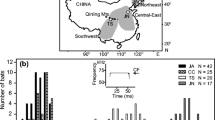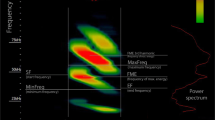Abstract
Poor knowledge of the intraspecific variability in echolocation calls is recognized as an important limiting factor for the accurate acoustic identification of bats. We studied the echolocation behaviors of an ecologically poorly known bat species, Myotis macrodactylus, while they were commuting in three types of habitats differing significantly in the amount of background clutter, as well as searching for prey above the water surface in a river. Results showed that M. macrodactylus altered their echolocation call structure in the same way during commuting as foraging bats do in relation to the changing level of clutter. With increasing level of clutter, M. macrodactylus generally produced echolocation calls with higher start, end, and peak frequencies; wider bandwidth; and shorter pulse duration. Compared to commuting, bats emitted significantly lower frequency calls with narrower bandwidth while searching for prey. Discriminant function analysis indicated that 79.8% of the calls from the three commuting habitats were correctly grouped, and 87% of the calls were correctly classified to the commuting and foraging contexts. Our finding has implications for those who would identify species by their calls.


Similar content being viewed by others
References
Adams MD, Law BS, Gibson MS (2010) Reliable automation of bat call identification for eastern New South Wales, Australia, using classification trees and AnaScheme software. Acta Chiropterol 12(1):231–245. doi:10.3161/150811010X504725
Barclay RMR (1999) Bats are not birds—a cautionary note on using echolocation calls to identify bats: a comment. J Mammal 80(1):290–296
Bartonicka T, Rehak Z (2005) Variability in echolocation calls of Pipistrellus pygmaeus (Chiroptera: Vespertilionidae) during search flight in different habitats. Acta Theriol 50(2):145–160. doi:10.1007/BF03194478
Berger-Tal O, Berger-Tal R, Korine C, Holderied MW, Fenton MB (2008) Echolocation calls produced by Kuhl's pipistrelles in different flight situations. J Zool 274(1):59–64. doi:10.1111/j.1469-7998.2007.00357.x
Boonman AM, Boonman M, Bretschneider F, van de Grind WA (1998) Prey detection in trawling insectivorous bats: duckweed affects hunting behaviour in Daubenton's bat, Myotis daubentonii. Behav Ecol Sociobiol 44(2):99–107. doi:10.1007/s002650050521
Britton ARC, Jones G, Rayner JMV (1997) Flight performance, echolocation and foraging behaviour in pond bats, Myotis dusycnerne (Chiroptera: Vespertilionidae). J Zool 241(3):522. doi:10.1111/j.1469-7998.1997.tb04842.x
Broders HG, Findlay CS, Zheng L (2004) Effects of clutter on echolocation call structure of Myotis septentrionalis and M. lucifugus. J Mammal 85(2):273–281. doi:10.1644/BWG-102
Ekman M, Jong J (1996) Local patterns of distribution and resource utilization of four bat species (Myotis brandti, Eptesicus nilssoni, Plecotus auritus and Pipistrellus pipistrellus) in patchy and continuous environments. J Zool 238(3):571–580. doi:10.1111/j.1469-7998.1996.tb05414.x
Fenton MB (1970) A technique for monitoring bat activity with results obtained from different environments in southern Ontario. Can J Zool 48(4):847–851. doi:10.1139/z70-148
Fenton MB (1997) Science and the conservation of bats. J Mammal 78(1):1–14
Fenton MB, Bell GP (1981) Recognition of species of insectivorous bats by their echolocation calls. J Mammal 62(2):233–243
Findley JS (1972) Phenetic relationships among bats of the genus Myotis. Syst Zool 21(1):31–52
Fukui D, Agetsuma N, Hill DA (2004) Acoustic identification of eight species of bat (Mammalia: Chiroptera) inhabiting forests of southern Hokkaido, Japan: potential for conservation monitoring. Zool Sci 21(9):947–955. doi:10.2108/zsj.21.947
Harada M, Yosida T (1978) Karyological study of four Japanese Myotis bats (Chiroptera, Mammalia). Chromosoma 65(3):283–291. doi:10.1007/BF00327623
Holderied MW, Jones G, von Helversen O (2006) Flight and echolocation behaviour of whiskered bats commuting along a hedgerow: range-dependent sonar signal design, Doppler tolerance and evidence for acoustic focussing. J Exp Biol 209(10):1816–1826. doi:10.1242/jeb.02194
Hwang H, Lee J (2007) Morphological study on the dorsal lingual papillae of Myotis macrodactylus. Korean J Electron Microsc 37:147–156
Jiang TL, Liu Y, Feng J (2008) A new Chinese record species. Acta Zootaxonomica Sinica 33(001):212–216
Jones G, Holderied MW (2007) Bat echolocation calls: adaptation and convergent evolution. Proc R Soc Lond B Biol 274(1612):905–912. doi:10.1098/rspb.2006.0200
Jones G, Siemers B (2010) The communicative potential of bat echolocation pulses. J Comp Physiol A:1–11. doi:10.1007/s00359-010-0565-x
Jones KE, Teeling EC (2009) Phylogenetic tools for examining character and clade evolution in bats. In: Kunz TH, Parsons S (eds) Ecological and behavioral methods for the study of bats. John Hopkins University Press, Baltimore, pp 715–738
Jones G, Vaughan N, Parsons S (2000) Acoustic identification of bats from directly sampled and time expanded recordings of vocalizations. Acta Chiropterol 2(2):155–170. doi:10.2193/0022-541X(2005)69[1601:IBFTRO]2.0.CO;2
Kalko EKV, Schnitzler HU (1993) Plasticity in echolocation signals of European pipistrelle bats in search flight: implications for habitat use and prey detection. Behav Ecol Sociobiol 33(6):415–428. doi:10.1007/BF00170257
Kawai K, Nikaido M, Harada M, Matsumura S, Lin LK, Wu Y, Hasegawa M, Okada N (2003) The status of the Japanese and East Asian bats of the genus Myotis (Vespertilionidae) based on mitochondrial sequences. Mol Phylogen Evol 28(2):297–307. doi:10.1016/S1055-7903(03)00121-0
Kazial K, Masters W (2004) Female big brown bats, Eptesicus fuscus, recognize sex from a caller's echolocation signals. Anim Behav 67(5):855–863. doi:10.1016/j.anbehav.2003.04.016
Krull D, Schumm A, Metzner W, Neuweiler G (1991) Foraging areas and foraging behavior in the notch-eared bat, Myotis emarginatus (Vespertilionidae). Behav Ecol Sociobiol 28(4):247–253. doi:10.1007/BF00175097
Kruskop S, Tsytsulina K (2001) A new big-footed mouse-eared bat Myotis annamiticus sp. nov. (Vespertilionidae, Chiroptera) from Vietnam. Mammalia 65(1):63–72. doi:10.1515/mamm.2001.65.1.63,//2001
Kunz TH, Arnett EB, Cooper BM, Erickson WP, Larkin RP, Mabee T, Morrison ML, Strickland MD, Szewczak JM (2007) Assessing impacts of wind-energy development on nocturnally active birds and bats: a guidance document. J Wildl Manage 71(8):2449–2486. doi:10.2193/2007-270
Lee J (2003) Cell differentiation and ultrastructure of the seminiferous epithelium in Myotis macrodactylus. Korean J Electron Microsc 33:25–39
Lee J, Mori T (2004) Annual cycle of the seminiferous epithelium of Myotis macrodactylus. J Fac Agric Kyushu Univ 49(2):355–365
Limpens H, Kapteyn K (1991) Bats, their behaviour and linear landscape elements. Myotis 29:39–48
Liu F, Song Y, Yan S, Luo J, Feng J (2009a) Structure and sequence variation of the mitochondrial DNA control region in Myotis macrodactylus. Chin J Zool 44(4):19–27
Liu Y, Jin LR, Metzner W, Feng J (2009b) Postnatal growth and age estimation in big-footed myotis, Myotis macrodactylus. Acta Chiropterol 11(1):105–111. doi:10.3161/150811009X465721
Luo J, Yan S, Song Y, Liu F, Feng J (2009) Characters of echolocation calls in Myotis macrodactylus. Chin J Zool 44(1):133–138
Murray SW, Kurta A (2004) Nocturnal activity of the endangered Indiana bat (Myotis sodalis). J Zool 262(2):197–206. doi:10.1017/S0952836903004503
Neuweiler G (1989) Foraging ecology and audition in echolocating bats. Trends Ecol Evol 4(6):160–166. doi:10.1016/0169-5347(89)90120-1
Nicholls B, Racey P (2006) Habitat selection as a mechanism of resource partitioning in two cryptic bat species Pipistrellus pipistrellus and Pipistrellus pygmaeus. Ecography 29(5):697–708. doi:10.1046/j.1365-2656.1999.00293.x
O’Farrell MJ, Miller BW, Gannon WL (1999) Qualitative identification of free-flying bats using the Anabat detector. J Mammal 80(1):11–23
Obara Y, Tomiyasu T, Saitoh K (1976) Chromosome studies in the Japanese Vespertilionid bats, 1: karyotypic variations in Myotis macrodactylus Temminck. Jap J Genet 51(3):201–206
Papadatou E, Butlin RK, Altringham JD (2008) Identification of bat species in Greece from their echolocation calls. Acta Chiropterol 10(1):127–143. doi:10.3161/150811008X331153
Parsons S, Jones G (2000) Acoustic identification of twelve species of echolocating bat by discriminant function analysis and artificial neural networks. J Exp Biol 203:2641–2656
Parsons S, Szewczak JM (2009) Detecting, recording, and analyzing the vocalizations of bats. In: Kunz TH, Parsons S (eds) Ecological and behavioral methods for the study of bats. John Hopkins University Press, Baltimore, pp 91–111
Preatoni DG, Nodari M, Chirichella R, Tosi G, Wauters LA, Martinoli A (2005) Identifying bats from time-expanded recordings of search calls: comparing classification methods. J Wildl Manage 69(4):1601–1614. doi:10.2193/0022-541X(2005)69[1601:IBFTRO]2.0.CO;2
Russell AL, Butchkoski CM, Saidak L, McCracken GF (2009) Road-killed bats, highway design, and the commuting ecology of bats. Endang Species Res 10:49–60. doi:10.3354/esr00121
Rydell J, Arita H, Santos M, Granados J (2002) Acoustic identification of insectivorous bats (order Chiroptera) of Yucatan, Mexico. J Zool 257(1):27–36. doi:10.1017/S0952836902000626
Sakai T, Kikkawa Y, Tsuchiya K, Harada M, Kanoe M, Yoshiyuki M, Yonekawa H (2003) Molecular phylogeny of Japanese Rhinolophidae based on variations in the complete sequence of the mitochondrial cytochrome b gene. Genes Genet Syst 78(2):179–189. doi:10.1266/ggs.78.179
Schaub A, Schnitzler HU (2007a) Echolocation behavior of the bat Vespertilio murinus reveals the border between the habitat types “edge” and “open space”. Behav Ecol Sociobiol 61(4):513–523. doi:10.1007/s00265-006-0279-9
Schaub A, Schnitzler HU (2007b) Flight and echolocation behaviour of three vespertilionid bat species while commuting on flyways. J Comp Physiol A 193(12):1185–1194. doi:10.1007/s00359-007-0269-z
Schnitzler HU, Kalko EKV (2001) Echolocation by insect-eating bats. Bioscience 51(7):557–569. doi:10.1641/0006-3568(2001)051[0557:EBIEB]2.0.CO;2
Schumm A, Krull D, Neuweiler G (1991) Echolocation in the notch-eared bat, Myotis emarginatus. Behav Ecol Sociobiol 28(4):255–261. doi:10.1007/BF00175098
Siemers BM, Schnitzler HU (2004) Echolocation signals reflect niche differentiation in five sympatric congeneric bat species. Nature 429(6992):657–661. doi:10.1038/nature02547
Siemers BM, Kalko EKV, Schnitzler HU (2001a) Echolocation behavior and signal plasticity in the Neotropical bat Myotis nigricans (Schinz, 1821)(Vespertilionidae): a convergent case with European species of Pipistrellus? Behav Ecol Sociobiol 50:317–328. doi:10.1007/s002650100379
Siemers BM, Stilz P, Schnitzler HU (2001b) The acoustic advantage of hunting at low heights above water: behavioural experiments on the European ‘trawling’ bats Myotis capaccinii, M. dasycneme and M. daubentonii. J Exp Biol 204(22):3843–3854
Son S, Lee J, Shin W, Choi B (1995) Spermiogenesis in the large footed bat, Myotis macrodactylus. Korean J Electron Microsc 25:96–110
Speakman J (1991) Why do insectivorous bats in Britain not fly in daylight more frequently? Funct Ecol 5(4):518–524
Verboom B, Huitema H (1997) The importance of linear landscape elements for the pipistrelle Pipistrellus pipistrellus and the serotine bat Eptesicus serotinus. Landscape Ecol 12(2):117–125. doi:10.1007/BF02698211
Verboom B, Boonman AM, Limpens H (1999) Acoustic perception of landscape elements by the pond bat (Myotis dasycneme). J Zool 248(01):59–66. doi:10.1111/j.1469-7998.1999.tb01022.x
Wund MA (2006) Variation in the echolocation calls of little brown bats (Myotis lucifugus) in response to different habitats. Am Midl Nat 156(1):99–108. doi:10.1674/0003-0031(2006)156[99:VITECO]2.0.CO;2
Acknowledgments
We thank Shi-han Yan, Yu Song, and Feng Liu for their considerable assistance in the field. We are grateful to Dr. Li-min Shi, Dr. Long-ru Jin, and Dr Ting-lei Jiang for their helpful comments on the early draft of this manuscript. This study was supported by the National Natural Science Foundation of China (grant no. 31030011, 30870371, 30900166) and by the Fundamental Research Funds for the Central Universities (grant no. 09SSXT034). We are also grateful to two anonymous reviewers for their helpful and critical comments.
Author information
Authors and Affiliations
Corresponding author
Additional information
Communicated by: Matthew E. Gompper
Rights and permissions
About this article
Cite this article
Luo, Jh., Ou, W., Liu, Y. et al. Plasticity in echolocation calls of Myotis macrodactylus (Chiroptera: Vespertilionidae): implications for acoustic identification. Acta Theriol 57, 137–143 (2012). https://doi.org/10.1007/s13364-011-0062-9
Received:
Accepted:
Published:
Issue Date:
DOI: https://doi.org/10.1007/s13364-011-0062-9




